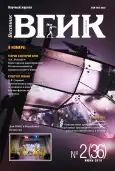The Influence of Traditions of Culture on the Techniques of Sound Directing in Japanese Cinema. Speech and Pause
- 作者: Rusinova E.A1, Khabchuk E.M1
-
隶属关系:
- VGIK
- 期: 卷 10, 编号 2 (2018)
- 页面: 74-84
- 栏目: WORLD CINEMA | ANALYSIS
- URL: https://journals.eco-vector.com/2074-0832/article/view/14582
- DOI: https://doi.org/10.17816/VGIK10274-84
- ID: 14582
如何引用文章
全文:
详细
The article (the end of the publication, beginning: No 1 (35), 2018) analyzes the sound features of Japanese motion pictures created in the second half of the 20th - beginning of the 21st centuries, on the example of the speech expressiveness of screen actors. The peculiarity of the acting game for a long time was one of the obstacles to understanding and accepting Japanese films by the Western audience. The approach of Japanese film actors to taking roles was based on traditions of the theatrical performance. However, theatrical techniques organically entered the artistic structure and became distinctive features of the genre of dzidaigaki (costume-historical film), especially loved by the audience. The main vehicle in the sound design of such films was the actor's speech using an ancient language, differing from modern Japanese by the presence of additional endings and pronouns. The mode of stylization of speech, associated with a special attention to detail, brings the audience closer to the time displayed on screen, adding realism in the perception of the screen event. The article presents stylistic, phonetic, semantic features of actor's speech in Japanese films not only in costume and historical genre, but also in fantasy and animation films. In the latter two genres, the onomatopoeia (sound imaging) plays an important role in creating the sound design of the film, which is so common in Japanese colloquial and written speech that can also be attributed to a peculiar Japanese cultural tradition. Analysis of sound designs of the Japanese films, including the use of onomatopoeia, is the novelty of the work presented. The article’s topicality is that analyzing another view of the world can broaden the horizon of seeing a specific creative task that is not even related to the “Japanese theme”, while opening up new creative opportunities. In addition, the material of the article in some extent fills a gap in Russian cinema studies, related to the theme of sound in Japanese cinema.
全文:
Abstract: The article (the end of the publication, beginning: No 1 (35), 2018) analyzes the sound features of Japanese motion pictures created in the second half of the 20th — beginning of the 21st century, on the example of the speech expressiveness of screen actors. The peculiarity of the acting game for a long time was one of the obstacles to understanding and accepting Japanese films by the Western audience. The approach of Japanese film actors to taking roles was based on traditions of the theatrical performance. However, theatrical techniques organically entered the artistic structure and became distinctive features of the genre of dzidaigaki (costume-historical film), especially loved by the audience. The main vehicle in the sound design of such films was the actor's speech using an ancient language, differing from modern Japanese by the presence of additional endings and pronouns.
The mode of stylization of speech, associated with special attention to detail, brings the audience closer to the time displayed on the screen, adding realism in the perception of the screening event. The article presents stylistic, phonetic, semantic features of the actor's speech in Japanese films not only in costume and historical genre but also in fantasy and animation films. In the latter two genres, the onomatopoeia (sound imaging) plays an important role in creating the sound design of the film, which is so common in Japanese colloquial and written speech that can also be attributed to a peculiar Japanese cultural tradition. Analysis of sound designs of the Japanese films, including the use of onomatopoeia, is the novelty of the work presented. The article’s topicality is that analyzing another view of the world can broaden the horizon of seeing a specific creative task that is not even related to the “Japanese theme”, while opening up new creative opportunities. In addition, the material of the article in some extent fills a gap in Russian cinema studies, related to the theme of sound in Japanese cinema.
作者简介
Elena Rusinova
VGIK
编辑信件的主要联系方式.
Email: editor@vestnik-vgik.com
PhD (Arts), Associate Professor, Vice Rector for Science, VGIK
俄罗斯联邦, MoscowElizaveta Khabchuk
VGIK
Email: editor@vestnik-vgik.com
sound designer, VGIK.
俄罗斯联邦, Moscow参考
- Гундзи М. Японский театр Кабуки / пер. с японского Б.В. Раскина. - М.: Прогресс, 1969. - 230 с.
- Ивасаки А. Современное японское кино / под общ. ред. и с предисл. Р.Н. Юренева. - М.: Искусство, 1962. - 522 с.
- Сокуров А. В центре океана: [эссе, рассказы]. - СПб.: Амфора, 2012. - 319 с.
补充文件







